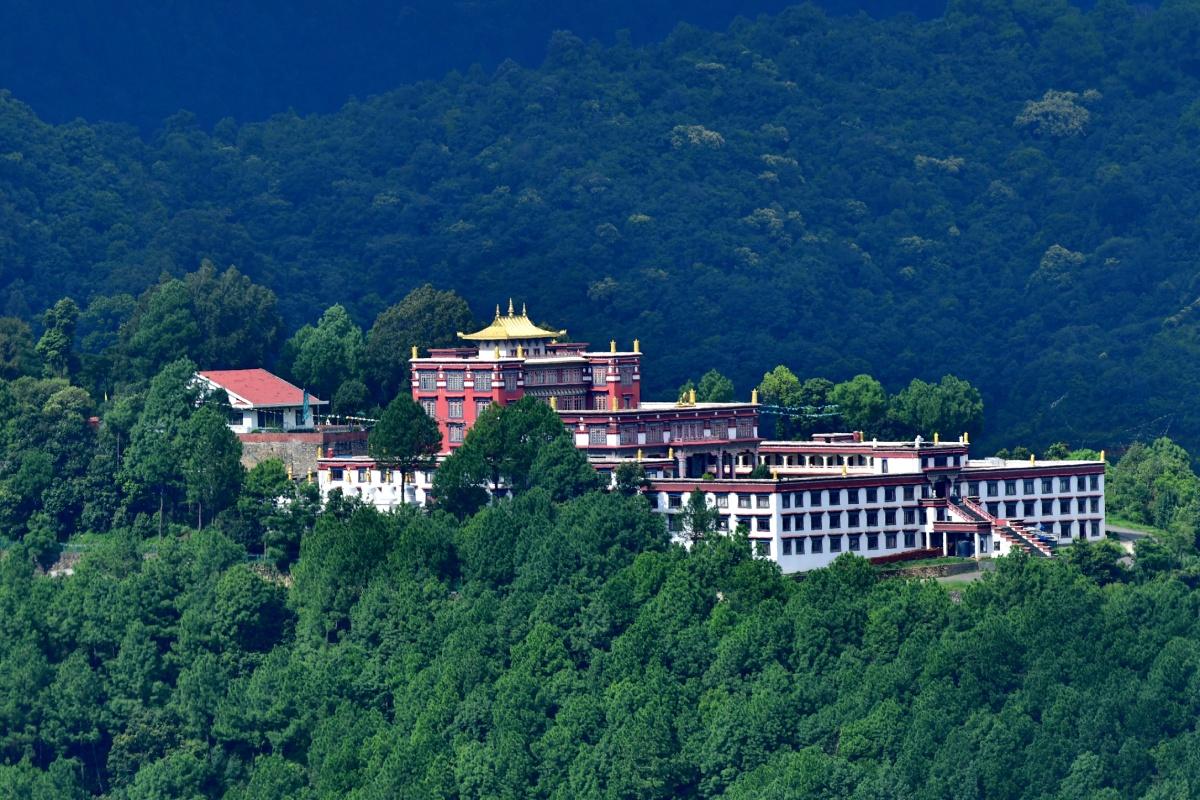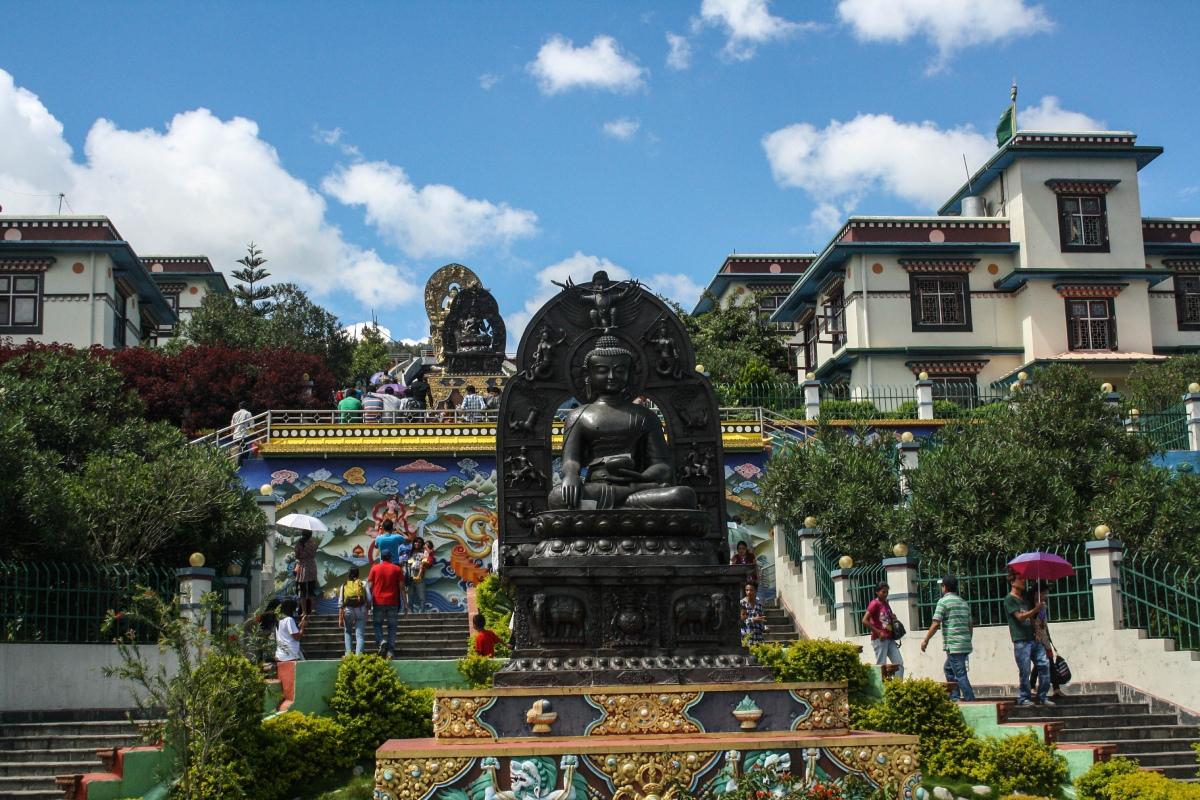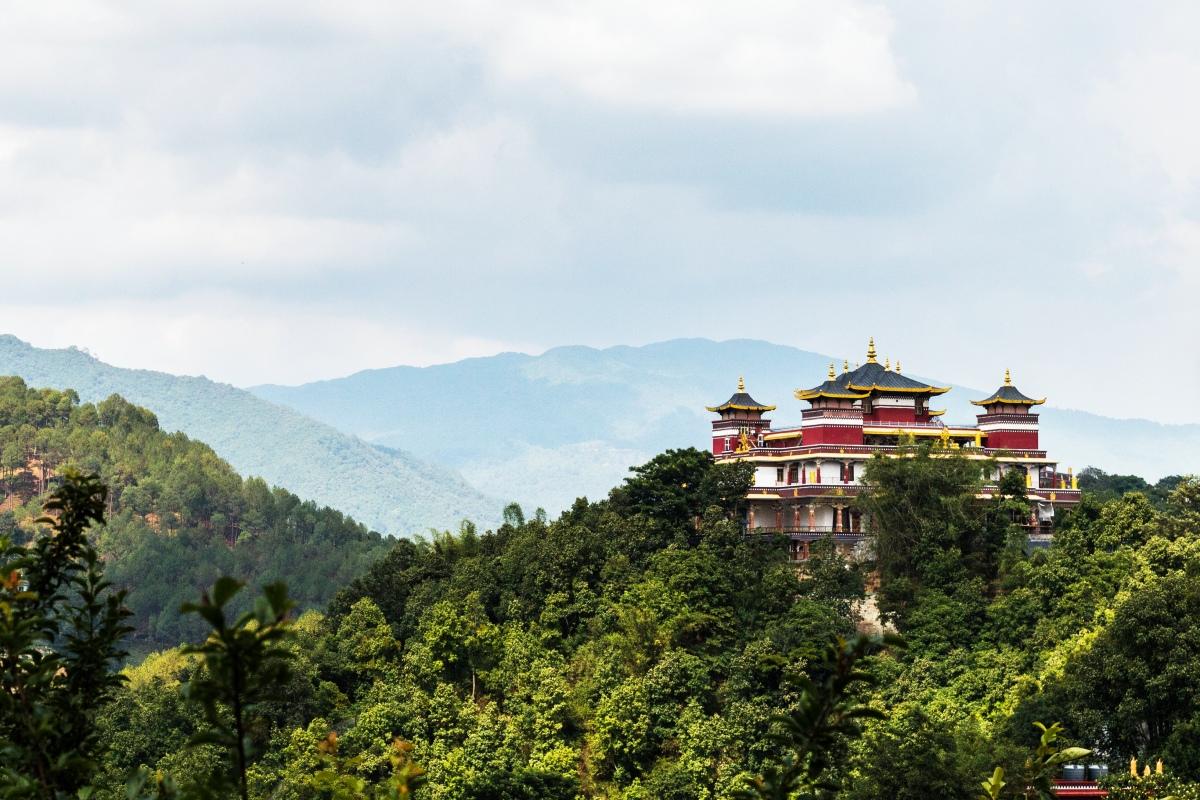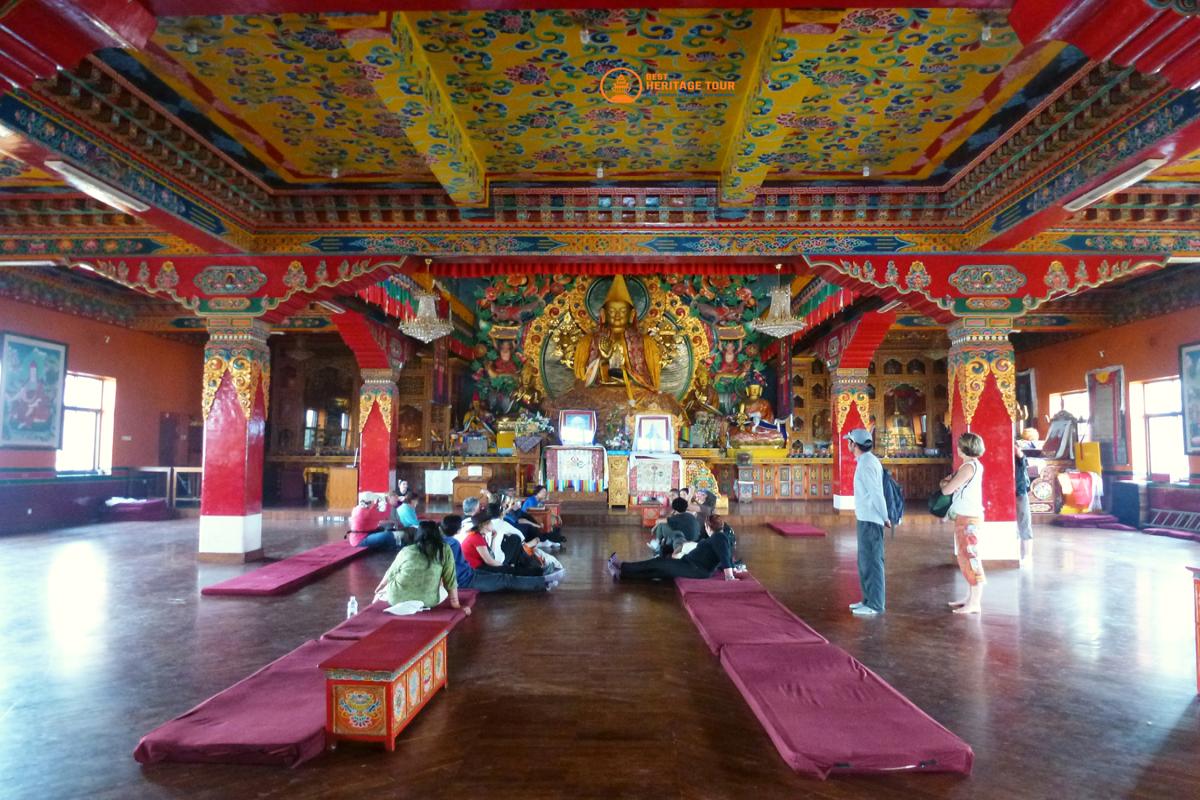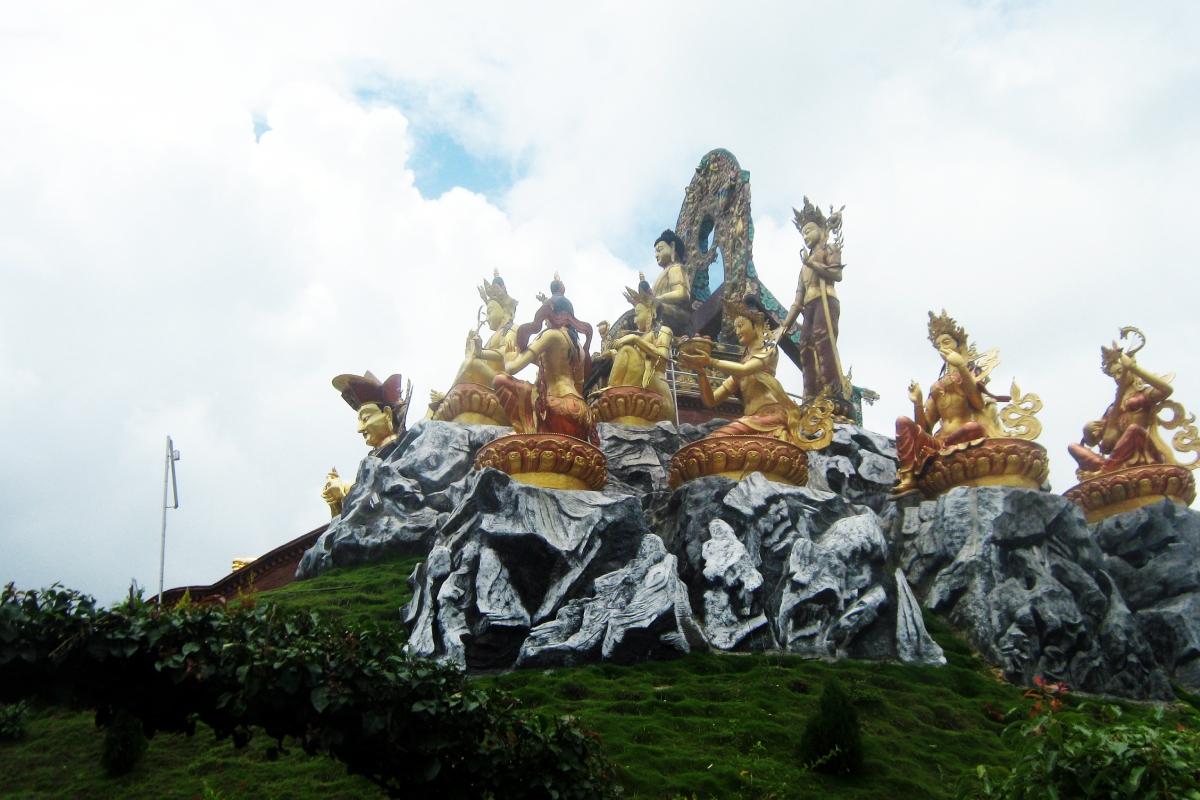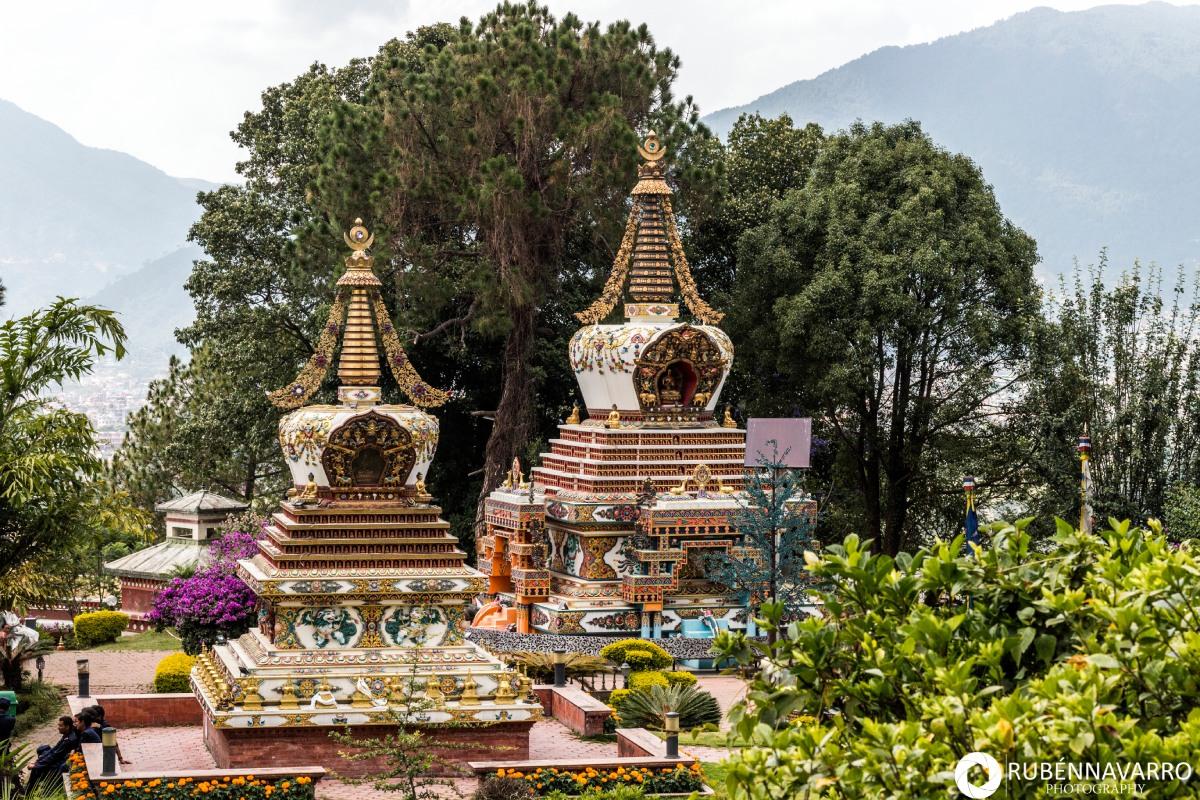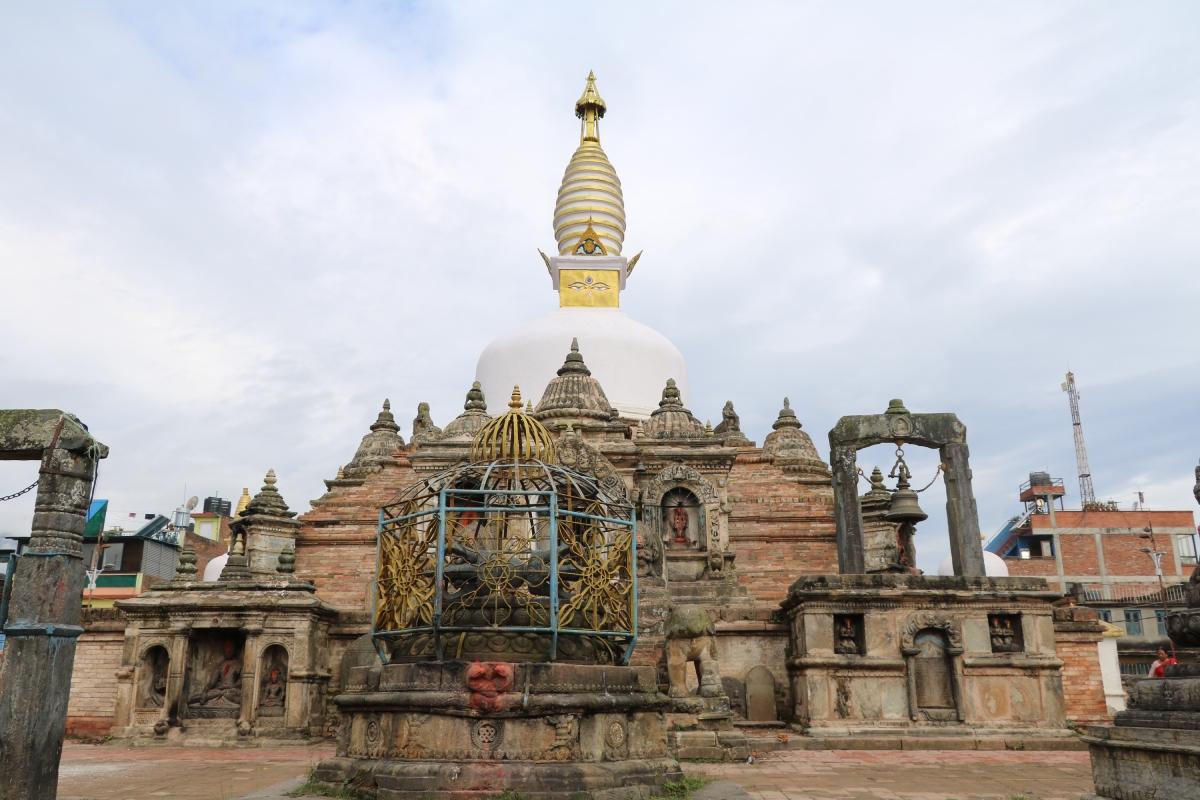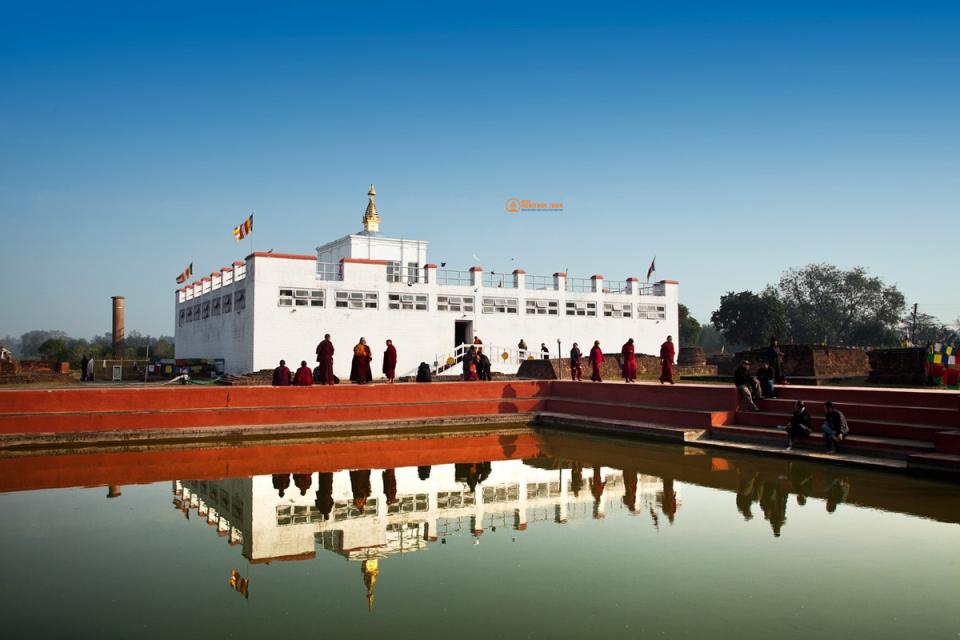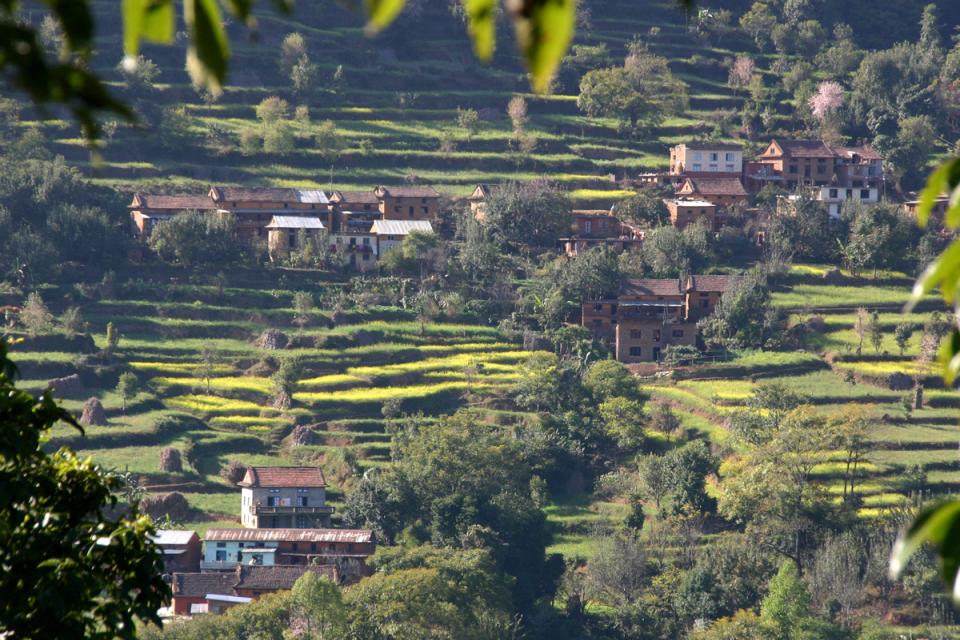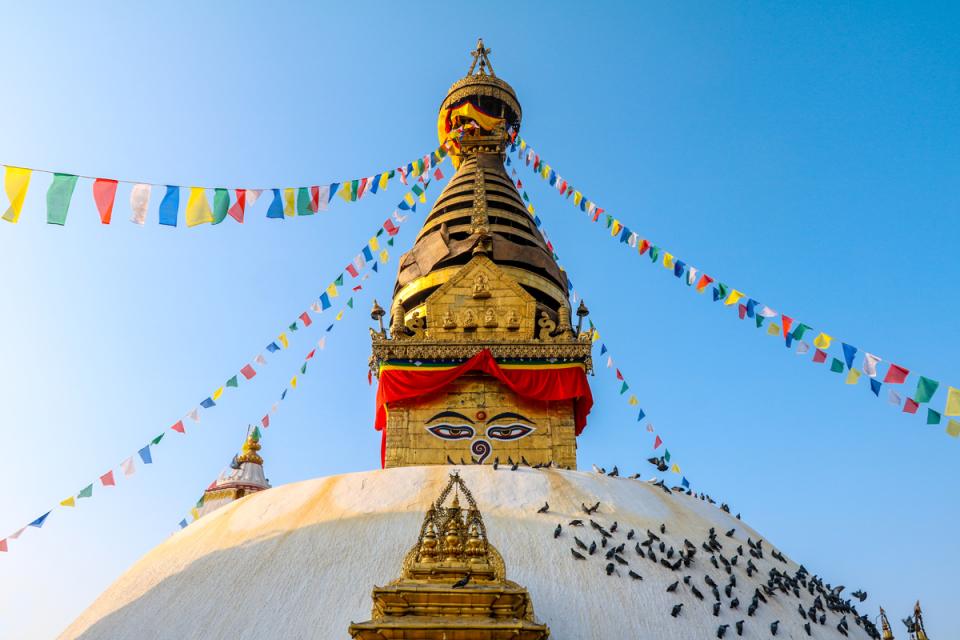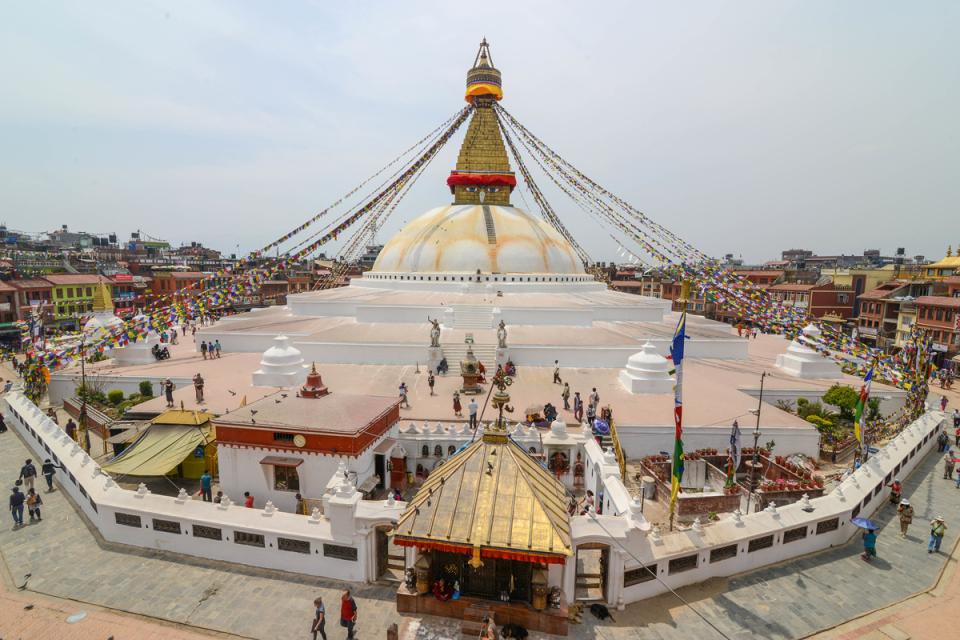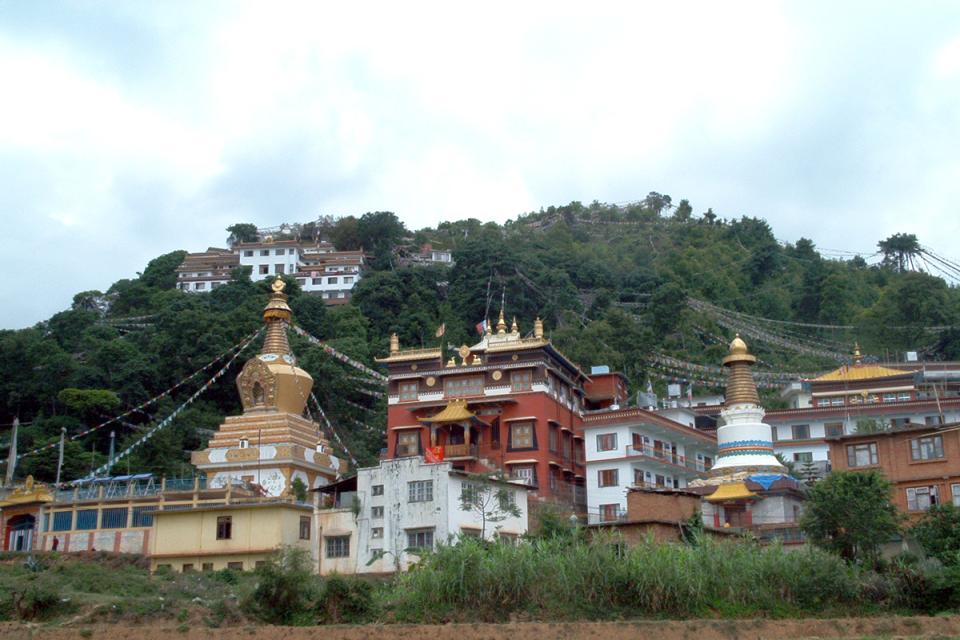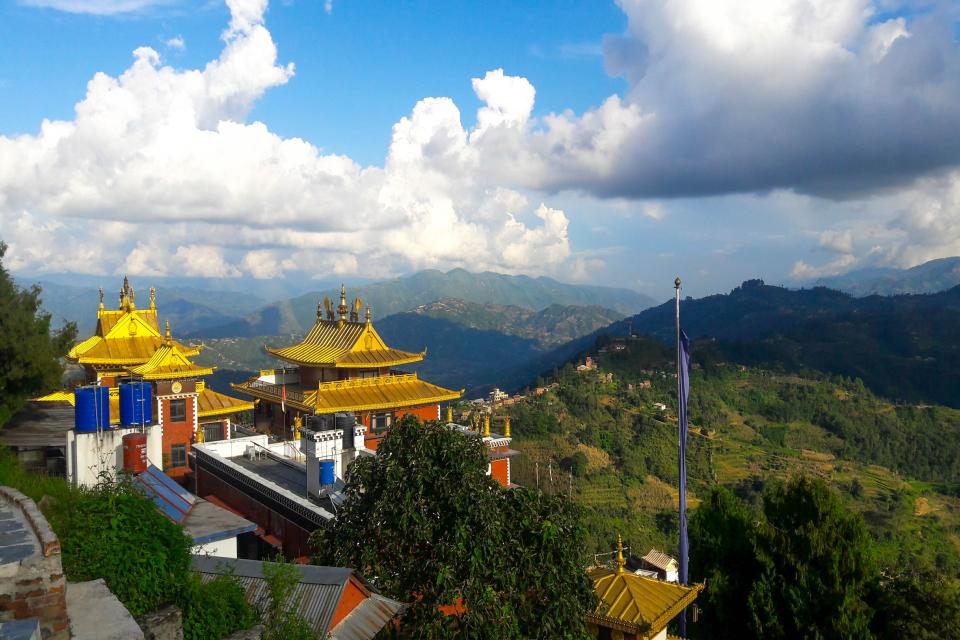4 (Four) Monastery Tour in Kathmandu - 1 Day
Insight on 4 (Four) Monastery Tour in Kathmandu
Embark on a journey of spiritual discovery with our 1-Day Monastery Tour in Kathmandu. Immerse yourself in the tranquility of Kapan Gumba, marvel at the ethereal beauty of Seto Gumba/Yellow Gompa, explore the vibrant artistry of Rato Gumba, and connect with history at Chilancho Stupa in Kirtipur. Perfect for seekers of peace, culture, and panoramic valley views, this tour offers an unforgettable glimpse into Nepal’s rich monastic traditions.
Trip at a Glance
Key Highlights
- Explore the peaceful Kopan Monastery, a renowned Tibetan Buddhist retreat
- Experience the spiritual ambiance and teachings at Kopan Monastery
- Visit Seto Gumba (White Monastery) for its stunning architecture and valley views
- Admire the intricate design and panoramic vistas at Seto Gumba
- Explore Yellow Gompa (Gelugpa Monastery) and gain insights into the teachings of the Gelugpa school of Tibetan Buddhism
- Experience the peaceful ambiance and distinctive yellow-roofed architecture of Yellow Gompa
- Discover Rato Gumba (Amitabha Monastery), a tranquil retreat amidst lush greenery
- Enjoy the serene atmosphere and meditation opportunities at Rato Gumba
- Explore the historic Chilancho Stupa and Kirtipur Gumba, rich in cultural heritage
- Appreciate the ancient artwork and historical significance of Chilancho Stupa
- Witness daily rituals and gain insight into the peaceful life of Buddhist monks
- Enjoy breathtaking views of the Himalayas and Kathmandu Valley
Benefits 4 (Four) Monastery Tour in Kathmandu with BHT
- Expert guides with knowledge of local culture, history, wildlife, and Buddhist philosophy
- Comfortable private transportation for a hassle-free experience
- Personalized service tailored to your interests and needs
- Flexible itinerary for enhanced exploration
- Transparent pricing with no hidden costs
- Easy booking & payment systems
- 24/7 support via multiple communication channels (Email, WhatsApp, etc.)
- Free luggage storage during the tour
Comprehensive Overview
Embark on our 1-Day Kathmandu Monastery Tour, a thoughtfully crafted journey that combines spiritual exploration, cultural immersion, and natural beauty to offer a uniquely enriching experience. Ideal for both first-time visitors and seasoned travelers, this tour provides a rare opportunity to delve into Nepal’s deep Buddhist heritage while enjoying stunning views of the Kathmandu Valley.
This tour is ideal for those looking for tranquility, introspection, and a richer understanding of Nepal's spiritual and cultural heritage. Whether you're a spiritual seeker or someone simply interested in exploring the beauty of Nepal’s monasteries, this tour will guide you through some of the most revered and tranquil Buddhist sites in Kathmandu.
You will visit spiritual sanctuaries where the teachings of Buddhism come to life, offering not only places of worship but also spaces of deep introspection and peace. The combination of sacred sites, cultural richness, and breathtaking natural beauty makes this tour an exceptional opportunity for spiritual and scenic enrichment.
1. Kopan Monastery (2,100m)
Our journey begins at Kopan Monastery, a renowned Tibetan Buddhist center known for its serene atmosphere and panoramic views. Perched on a hilltop just outside the bustling city of Kathmandu, Kopan provides a peaceful retreat for those seeking a deeper understanding of Buddhism and meditation. Founded in 1971, it has become a global center for Tibetan Buddhist teachings and meditation retreats.
-
Spiritual Significance: As a center for Tibetan Buddhist teachings, Kopan Monastery offers spiritual seekers the chance to learn from experienced monks. Visitors can engage in guided meditation sessions or attend teachings on Buddhist philosophy, making it an ideal place for both spiritual beginners and experienced practitioners.
-
Meditation and Teachings: The monastery regularly conducts meditation courses, making it an excellent place to learn about Tibetan Buddhist practices, such as mindfulness and mantra chanting.
-
Scenic Beauty: Situated on a hill, the monastery offers sweeping views of the Kathmandu Valley, creating a tranquil space for contemplation and introspection amidst the beauty of the surrounding hills and mountains.
2. Seto Gumba (White Monastery)
Seto Gumba, or the White Monastery, is known for its pristine white walls and striking Tibetan architecture. Located atop a hill, this peaceful monastery offers an excellent vantage point for taking in the panoramic views of the Kathmandu Valley. The monastery is also famous for its artistic murals that depict scenes of Tibetan Buddhism, including important deities and celestial beings.
-
Architectural Wonder: The monastery’s stark white exterior stands out against the lush greenery surrounding it. Inside, visitors can marvel at intricate murals and frescoes, which depict various aspects of Tibetan Buddhist teachings, including scenes from the lives of the Buddha and other revered Buddhist figures.
-
Peaceful Retreat: The tranquil atmosphere of Seto Gumba makes it an ideal place for meditation. Visitors can take part in quiet contemplation or engage with monks to learn about their practices and way of life.
-
Panoramic Views: From Seto Gumba, you can enjoy 360-degree views of the Kathmandu Valley, including distant views of the Himalayas on clear days. The combination of spiritual peace and scenic beauty makes this site a must-visit.
3. Yellow Gompa (Gelugpa Monastery)
Yellow Gompa, also known as Gelugpa Monastery, is a significant site for Tibetan Buddhist practices, offering a deep connection to the Gelugpa tradition of Tibetan Buddhism. This monastery is known for its vibrant yellow-roofed structures and its peaceful setting.
-
Significance of the Gelugpa Tradition: The Gelugpa school is one of the four major Tibetan Buddhist traditions, and Yellow Gompa serves as an important center for the study and practice of its teachings, particularly around discipline and compassion.
-
Vibrant Architecture: The monastery is distinguished by its bright yellow roof, a hallmark of the Gelugpa tradition, symbolizing wisdom and enlightenment. Visitors can explore the serene temple and participate in local rituals.
-
Spiritual Experience: Yellow Gompa provides a serene atmosphere for meditation, prayer, and reflection. The monks' daily practices offer a profound insight into Tibetan Buddhist life and teachings.
4. Rato Gumba (Amitabha Monastery)
The next stop is Rato Gumba, or Amitabha Monastery, a serene and secluded retreat located amidst lush forests. This monastery is dedicated to Amitabha Buddha, the Buddha of Infinite Light, and its teachings emphasize compassion, wisdom, and the path to enlightenment. The surrounding nature adds to the monastery’s peaceful environment, making it a perfect place for meditation and spiritual reflection.
-
Natural Serenity: Rato Gumba is nestled within a forested area, offering visitors a refreshing escape from the noise of the city. The monastery grounds are surrounded by trees and plants, creating a quiet atmosphere ideal for inner peace and reflection.
-
Buddhist Philosophy: The teachings at Rato Gumba focus on the principles of Mahayana Buddhism, which emphasize compassion for all living beings and the wisdom to understand the impermanence of life. Visitors can learn about these teachings through both formal sessions and informal conversations with the monks.
-
Cultural Immersion: As a center for Tibetan Buddhist meditation and practice, Rato Gumba provides a unique opportunity to interact with monks and learn about their daily rituals, prayers, and spiritual practices. It is an enriching cultural experience that offers deep insights into the Tibetan Buddhist way of life.
5. Kirtipur (Chilancho Stupa)
The final stop on the tour is Kirtipur, where you will visit the historic Chilancho Stupa. One of the oldest stupas in the Kathmandu Valley, Chilancho Stupa holds immense cultural and spiritual significance for the local Buddhist community. The stupa is adorned with intricate carvings and religious motifs that tell the story of Buddhist teachings and the life of the Buddha.
-
Historical Significance: The Chilancho Stupa is believed to date back to the 10th century, making it an important symbol of Nepal’s long-standing Buddhist heritage. It is one of the few stupas in the Kathmandu Valley that still preserves its original structure and significance, offering visitors a direct link to the ancient Buddhist traditions of Nepal.
-
Architectural Splendor: The stupa’s design features ornate carvings, sculptures, and painted murals that depict significant Buddhist figures and teachings. The stupa is an example of the intricate artistry found in Nepalese Buddhist architecture.
-
Cultural and Spiritual Insights: As a center of local religious practice, Chilancho Stupa is an active site for rituals and prayers. Visitors can observe monks and devotees engaging in ceremonies, offering a deeper understanding of the role of stupas in Buddhist worship and daily life.
-
Peaceful Surroundings: Located on a quiet hill in Kirtipur, the stupa provides a peaceful setting with views of the surrounding valley and hills, making it a serene place for reflection on Buddhist concepts such as life, death, and rebirth.
Troughout the day, visitors will not only explore Kathmandu’s spiritual landmarks but also enjoy breathtaking views of the valley and surrounding mountains. The blend of sacred sites, rich cultural heritage, and natural beauty makes this tour an exceptional way to experience both Nepal’s spiritual essence and the serenity of the Kathmandu Valley.
Itinerary
8:00 AM – Pickup from Your Hotel in Kathmandu
Your day begins with an 8:00 AM pickup from your hotel in Kathmandu. After meeting your guide, you’ll embark on a scenic drive to the first stop of your spiritual journey.
9:00 AM – Visit Kopan Monastery
Arrive at Kopan Monastery around 9:00 AM. Perched on a hilltop with stunning views of the Kathmandu Valley, this Tibetan Buddhist monastery is renowned for its serene ambiance and its significance as a meditation center.
- Duration: 2 hours
- Highlights:
- Explore the monastery grounds and enjoy its tranquil environment.
- Learn about Tibetan Buddhist philosophy and teachings.
- Discover the tranquility of the monastery while taking in the sweeping vistas of the Kathmandu Valley.
11:00 AM – Drive to Seto Gumba (White Monastery)
After departing from Kopan, your next stop is Seto Gumba, also known as the White Monastery, a 45-minute drive away. Renowned for its striking white architecture and detailed murals, the monastery offers breathtaking views of the surrounding valley.
- Duration: 1 hours
- Highlights:
- Admire the white walls and the art inside the monastery, which depicts scenes from Tibetan Buddhism.
- Enjoy breathtaking views of the Kathmandu Valley and surrounding hills.
- Take time to meditate or reflect in the peaceful atmosphere.
Optional Visit: Yellow Gompa (Gelugpa Monastery)
If you wish to extend your journey, you may opt to visit Yellow Gompa, a Tibetan Buddhist monastery that follows the Gelugpa tradition. It’s a short drive from Seto Gumba, offering a deeper insight into Buddhist practices.
- Duration: 1 hour
- Highlights:
- Explore the monastery and its unique architectural style.
- Learn about the Gelugpa tradition, one of the major schools of Tibetan Buddhism.
- Enjoy a peaceful, meditative atmosphere.
1:00 PM – Lunch Break (Self-Paid) at a Local Restaurant
Around 1:00 PM, enjoy a self-paid lunch at a local restaurant near Seto Gumba. This is a great opportunity to try traditional Nepali or Tibetan dishes, such as momos, dal bhat, or thukpa.
2:30 PM – Proceed to Rato Gumba (Amitabha Monastery)
After lunch, take a 30-minute drive to Rato Gumba, also known as Amitabha Monastery. Nestled in a lush forest, this monastery offers a serene environment for spiritual reflection and meditation.
- Duration: 1 hours
- Highlights:
- Immerse yourself in the peaceful surroundings and natural beauty.
- Learn about the teachings of Amitabha Buddha, focusing on compassion, wisdom, and enlightenment.
- Explore the monastery’s architecture and connect with the spiritual atmosphere.
3:30 PM – Visit Chilancho Stupa and Kirtipur Monastery
Your final stop is Chilancho Stupa and the nearby Kirtipur Monastery, located in Kirtipur. The stupa is one of the oldest in the Kathmandu Valley, offering a unique glimpse into Nepal's Buddhist history.
- Duration: 1.5 hours
- Highlights:
- Admire the ancient stupa’s carvings, sculptures, and religious motifs.
- Learn about the stupa’s historical significance, dating back to the 10th century.
- Visit Kirtipur Monastery for additional spiritual insights and peaceful reflection.
5:00 PM – Return to Kathmandu and Drop-Off at Your Hotel
After a full day of spiritual exploration and cultural immersion, your guide will drive you back to Kathmandu, where you will be dropped off at your hotel by 5:00 PM.
What is included?
- Private transportation for full-day tour
- Visits to four monasteries: Kopan Monastery, Seto Gumba, Yellow Gompa, Rato Gumba, and Chilancho Stupa.
- Insight into Buddhist teachings and daily rituals at each monastery
- The itinerary allows for adaptability to cater to individual exploration preferences
- Bottled water during the tour
- Driver salary allowances
What is not included?
- Expert guide with knowledge of Buddhist philosophy and local culture
- All necessary entry fees for the monasteries
- Meals and accommodation
- Meals (lunch is self-paid at a local restaurant)
- Personal expenses (e.g., souvenirs, snacks)
- Tips for guide and driver (optional)
- Travel insurance (recommended)
- All government taxes 13%, SSF, and 10% service charges
Route Map
Equipment
Embarking on the 1-Day Kathmandu Monastery Tour, you’ll be visiting some of the most serene and culturally significant Buddhist sites in the Kathmandu Valley. To make your spiritual journey as comfortable and enriching as possible, here’s a list of essential gear and equipment to bring along:
-
Comfortable Footwear: Since you'll be walking around monastery grounds and temples, comfortable shoes are essential. Opt for supportive shoes that can easily be removed when entering sacred spaces.
-
Sun Protection: Even though the altitudes are moderate, the sun can be intense, especially at higher altitudes like Kopan Monastery. Bring sunglasses, a hat, and sunscreen to protect yourself from UV rays.
-
Water Bottle: Staying hydrated throughout the day is important, especially as you’ll be walking and exploring for several hours. Bring a reusable water bottle to carry along.
-
Modest Clothing: When visiting monasteries and sacred sites, it’s respectful to dress modestly. Avoid shorts or revealing clothing, and aim for clothing that covers your shoulders and knees. A light scarf or shawl can also be useful for additional coverage.
-
Camera/Phone: The monasteries are rich in artistic beauty and offer scenic views of the Kathmandu Valley and the Himalayas. Ensure your camera or phone is fully charged to capture the stunning landscapes and sacred artwork.
-
Small Backpack or Daypack: A small, comfortable backpack can help carry your essentials such as your water, snacks, camera, and any extra layers of clothing you might need throughout the day.
-
Light Jacket or Sweater: Depending on the season, mornings and evenings can be chilly. A light jacket or sweater will ensure you're comfortable, especially when visiting the monasteries at higher altitudes.
-
Cash for Meals & Souvenirs: While the tour covers transportation and monastery entry fees, lunch is self-paid at a local restaurant. You might also want some cash for any optional souvenirs or donations at the monasteries.
-
Personal Medications: If you take any personal medications or have specific health needs, be sure to bring them along. It’s always a good idea to have a small first-aid kit with essentials like pain relievers and band-aids.
Trip Info
-
Best Seasons for the Tour
The best seasons for a monastery tour in Kathmandu offer unique experiences depending on the time of year. Each season has its own charm, catering to different preferences for weather, crowds, and the spiritual ambiance of the monasteries.
- Autumn (September to November): This is the most favorable season for the tour. The weather is clear and cool, offering excellent visibility for the panoramic views from the monasteries. The Kathmandu Valley's lush greenery is in full bloom, and the spiritual atmosphere is heightened by the festive mood surrounding the major religious celebrations during this time.
- Spring (March to May): Another great season, with mild temperatures and clear skies. Springtime brings vibrant blooms and pleasant weather for the monasteries’ peaceful settings. This is also an ideal time for spiritual seekers as the climate is comfortable for long hours of reflection or meditation.
- Winter (December to February): While the weather can be chilly, especially in the mornings and evenings, the crowds are fewer, allowing for a more tranquil experience at the monasteries. The Kathmandu Valley may be misty in the mornings but usually clears up during the day. A warm jacket and layers are recommended.
- Summer (June to August): The monsoon season brings heavier rainfall, which can create muddy conditions, especially on the hills leading to the monasteries. It is less ideal for outdoor activities, but for those who are flexible with weather conditions and want a quieter, less crowded experience, this can still be an option.
Additional Information
-
Altitude Considerations
The highest point reached on this tour is around 1,600 meters, specifically at Kopan Monastery. This is considered a relatively low altitude and generally does not pose any risk of altitude sickness. However, it’s still a good idea to be mindful of how your body responds to the elevation, especially if you're not accustomed to higher altitudes. At this level, the air remains breathable, and the climate is typically temperate, making it ideal for leisurely exploration.
While the altitude itself is not a concern, if you have a history of altitude-related issues or any health concerns related to air pressure changes, it's wise to consult with a healthcare professional before your tour. Remember to stay hydrated and avoid strenuous activities during the tour. The trek is not physically demanding, but paying attention to your body’s response is essential for a comfortable and enjoyable experience.
-
Guide Expertise
At Best Heritage Tour, we take pride in our expert guides, who are highly knowledgeable in Buddhist philosophy, local culture, and the rich history of the monasteries you will visit. Our guides are well-versed in the spiritual significance of these sacred sites and will provide you with a deeper understanding of their origins and monastic practices. Their extensive knowledge allows them to share fascinating stories, legends, and teachings that enhance your experience, offering new layers of meaning to each stop on the tour.
Moreover, our guides excel at explaining the symbolism behind the artwork found within the monasteries, such as the intricate murals and thangkas. Their insights help you connect with the spiritual essence of the monasteries, providing a profound appreciation of the rituals and the deeper practices of the monks. With Best Heritage Tour, you will gain a richer and more rewarding experience as you explore the spiritual heart of the Kathmandu Valley.
-
Travel Insurance
While the Kathmandu Monastery Tour is not physically strenuous, it’s always advisable to have travel insurance. Travel insurance provides coverage for unexpected situations, such as medical emergencies, cancellations, or lost baggage, ensuring that you are financially protected during your trip. This peace of mind allows you to focus on your spiritual journey without worrying about potential disruptions.
Even though the risks are low on this tour, having travel insurance is a small but wise investment to safeguard against unforeseen events. It also covers activities outside the monastery visits, such as travel delays, trip interruptions, and potential medical issues. By securing travel insurance, you ensure a smooth and stress-free experience, making the most of your time exploring these sacred sites.
-
Spiritual Etiquette and Local Interaction
At Best Heritage Tour, we emphasize the importance of respecting the peaceful environment of the monasteries, which are dedicated spaces for meditation, reflection, and spiritual practice. We encourage all visitors to maintain a quiet and calm demeanor to preserve the tranquil atmosphere. It is customary to remove shoes before entering sacred spaces, such as prayer halls, as a sign of reverence and respect for the Buddhist tradition.
Throughout the tour, you will have the opportunity to interact with local monks and devotees, which adds a deeply enriching aspect to your visit. Many monasteries welcome visitors and encourage meaningful conversations about their daily practices, beliefs, and meditation techniques. These interactions provide an invaluable opportunity to gain deeper insight into Buddhist teachings and foster a more intimate connection to the spiritual community.
-
Sacred Art and Photography
At Best Heritage Tour, we ensure that your visit to the monasteries is a culturally enriching experience, including the opportunity to explore magnificent works of sacred art. The monasteries are home to impressive murals, thangkas, and sculptures that depict key Buddhist deities, teachings, and stories. These works are not only aesthetically captivating but also steeped in deep symbolism, serving as teaching tools for both the monks and visitors. The art provides valuable insights into Buddhist philosophy and is integral to the spiritual atmosphere of the monasteries.
The monasteries' unique architecture and stunning natural surroundings also offer fantastic photography opportunities. However, it is important to follow photography guidelines, particularly in sacred spaces. Some areas may have restrictions on photography to maintain the sanctity of the site or to avoid interruptions during prayer rituals. At Best Heritage Tour, we guide you in respecting these customs, ensuring you ask for permission where necessary and follow local rules to capture your memories without disturbing the peaceful environment.
-
Healing, Meditation, and Cultural Engagement
Several monasteries, such as Rato Gumba, offer the opportunity to participate in meditation sessions or mindfulness practices. These guided sessions are tailored to help you relax and reflect, allowing you to connect with your inner self. Whether you are a seasoned meditator or a beginner, these sessions provide a peaceful environment to practice mindfulness and experience the benefits of meditation.
If your visit coincides with a Buddhist festival, such as Losar (Tibetan New Year) or Buddha Jayanti (Buddha’s Birthday), you’ll be able to experience the local community’s vibrant cultural celebrations. These festivals often include traditional dances, music, and processions, giving you a deeper connection to the Buddhist community. You may also learn about how monasteries are involved in community engagement, such as supporting education, charity work, or environmental initiatives.
-
Health and Well-being
At Best Heritage Tour, we recognize that the serene environment of the monasteries, surrounded by lush greenery and peaceful landscapes, plays a vital role in promoting mental well-being. Being in nature and immersed in spiritual practices allows visitors to relax, reduce stress, and gain clarity in their thoughts. The tranquil surroundings provide an ideal setting for deep reflection and self-care, offering opportunities for personal growth and rejuvenation.
Our tour creates a perfect balance of nature, culture, and spirituality, helping to restore inner peace and mental health. Whether you seek a peaceful retreat or wish to reconnect with yourself, the monasteries offer a calm and restorative environment. The combination of spiritual practices like meditation, combined with the natural beauty of the surroundings, ensures that our guests experience long-term mental wellness and emotional clarity.
-
Booking & Payment
Best Heritage Tour is a well-established tour operator, licensed, registered, and insured by the Government of Nepal. We have been offering our services for over 15 years, ensuring you a reliable and professional experience.
We are proud members of the Nepal Trekking Agencies Association (TAAN) and the Nepal Mountaineering Association (NMA), so when you book with Best Heritage Tour, you can do so with full confidence.
To secure your tour reservation, a deposit of 10% of the total tour fee is required. This can be paid via bank transfer, online payment, or other available methods. Upon your arrival, the remaining balance can be settled via cash, bank transfer, or credit card. We will provide you with payment details and available payment options after your booking.
-
Last minute bookings
Booking in advance is ideal, but for those who can't, Best Heritage Tours provides options for last-minute bookings. For last-minute trip bookings, 100% of the trip price must be paid at least 24 hours before the trek departure date. We strive to offer trekking tours at any time. However, for last-minute bookings, we cannot be held responsible for delays due to factors beyond our control, like bad weather or lack of available accommodation. For more information, please contact us at +977-9851163046/+977-9810043046 or email info@bestheritagetour.com.
-
Customization
At Best Heritage Tour, we understand that every traveler has unique preferences. Our Kathmandu Monastery Tour is designed to be flexible and can be tailored to suit your individual interests. Whether you're drawn to cultural exploration, spiritual practices, or historical insights, the tour can be customized to focus on what matters most to you. This flexibility allows you to immerse yourself in the aspects of the tour that resonate most with your personal preferences or spiritual needs.
For groups, we can further adapt the tour to accommodate varying interests, ensuring that each participant enjoys a fulfilling and engaging experience. Whether you wish to attend specific rituals, explore art and architecture, or spend extra time in meditation, the itinerary can be adjusted to meet your group's unique dynamics. Customization guarantees that your tour is not only enjoyable but also personally enriching.
Note: This tour is ideal for cultural enthusiasts and spiritual seekers looking to connect with Nepal’s rich Buddhist heritage, offering not only a serene environment for introspection but also an immersive cultural experience.
Review
Beautiful monastery with peaceful environment
One of the most amazing monastery tour around Kathmandu valley. I got to explore the Tibetan influenced monastery and views from those monastery are awesome, especially from the...
View DetailLearned something new
I should not back out to suggest such an amazing monastery tour with the amazing person Mr. Bimal. Knowing the history and religious as well as cultural significance of those...
View DetailGood family friendly monastery tour
Our family had a great time in this 4 monastery tour. During this tour we explore those monastery and taught my children about the Buddha and Buddhist religion. Also the atmosphere...
View DetailGot to explore Tibetan influenced monastery
Best tour in Kathmandu valley with Best heritage tour to explore different monastery. A different type of tour which mainly focuses on Buddhist religion and Tibetan art and...
View DetailFAQ's
While Nepali is the primary language, most staff members in lodges speak English, and some may even speak other languages. Communication should not be an issue for international tourists.
It’s advisable to be up-to-date on routine vaccinations, including hepatitis A and typhoid. Talk to your doctor about the vaccinations you need for Nepal.
The majority of international flights arrive at Tribhuvan International Airport, which is located in Kathmandu. From this location, travelers can connect to Lukla to commence their trekking journey.
You typically need a valid passport, a completed visa application form, and a passport-sized photo. Payment can be made in cash or via card at the airport.
Yes, tourist visas are eligible for extension at the Department of Immigration located in Kathmandu. Ensure you have a valid reason and required documents for the extension.
If you wish to extend your stay in Nepal beyond your visa’s initial duration, you can do so by applying at the Department of Immigration in Kathmandu. Extensions are available for a maximum of 30 days, and it’s recommended to apply before your current visa expires. Best Heritage Tour can help you with the extension process if required during your Australian Camp Trek.
The One-Day Monastery Tour in Kathmandu is a spiritual and cultural excursion designed for travelers to explore four significant monasteries in the Kathmandu Valley. The tour visits Kopan Monastery, White Gompa (Seto Gompa), Yellow Gompa (Gelugpa Monastery), and Amitabha Monastery/Chilancho Stupa. It offers an immersive experience of Nepal's Buddhist heritage and serene surroundings. The journey typically lasts around 8–9 hours, with a private vehicle provided for transportation. Best Heritage Tour ensures a smooth and enriching experience throughout.
The key highlights of this tour include experiencing the peaceful atmosphere of Kathmandu’s monasteries, viewing stunning Himalayan vistas from higher altitudes, and exploring the rich Buddhist heritage. You'll also have the opportunity to meditate or participate in rituals depending on the monastery’s activities. The tour is perfect for spiritual seekers and culture enthusiasts alike.
This tour is suitable for cultural enthusiasts, spiritual seekers, or anyone interested in Nepalese Buddhist culture. Whether you are a solo traveler, couple, or part of a group, the One-Day Monastery Tour offers a perfect balance of peace, history, and natural beauty.
Absolutely! This tour is designed for people of all backgrounds. Best Heritage Tour ensures that the guides are well-informed and can explain the significance of each monastery in simple terms. It’s an excellent introduction to Buddhism and the spiritual practices of Nepal.
You will be picked up from your hotel in Kathmandu and driven to each monastery. At each location, the guide will provide an overview of the monastery’s history and importance in the Buddhist community. There will be opportunities to ask questions, take photos, and even meditate. Expect to be surrounded by serenity, stunning architecture, and beautiful views of the valley.
The tour typically lasts between 8 and 9 hours, depending on the time spent at each monastery. It begins in the morning and concludes in the afternoon with a drop-off back at your hotel. Best Heritage Tour ensures a comfortable schedule that includes time for exploration, meditation, and relaxation.
The tour lasts approximately 8 to 9 hours, with the visit to each monastery taking around 1-1.5 hours. The duration can vary slightly depending on the time spent at each site.
Yes, Best Heritage Tour provides comfortable private transportation throughout the tour. You will be picked up from your hotel and driven between the monasteries in a private vehicle, ensuring a relaxing and smooth journey.
The tour typically starts early in the morning, around 8:00 AM, to maximize daylight hours for sightseeing. However, timings can be adjusted based on your preferences and schedule.
The best time for this tour is during the dry seasons, which are from September to November and March to May. During these months, the weather is clear and pleasant, ideal for exploring the monasteries.
Best Heritage Tour provides private, comfortable vehicles for transportation, ensuring a hassle-free journey from one monastery to another. The vehicles are well-maintained and equipped for your comfort.
There is a moderate amount of walking, especially around the monastery premises. However, the walking distance is manageable for most people. Comfortable footwear is recommended.
Yes, a knowledgeable guide accompanies you on this tour, providing insightful information about the monasteries' history, architecture, and significance in Buddhism.
Yes, Best Heritage Tour offers flexible options. If you wish to modify the itinerary or include additional stops, you can discuss your preferences when booking, and we will do our best to accommodate your needs.
Yes, the One-Day Monastery Tour is available daily, subject to availability. You can book it anytime based on your schedule.
The monasteries are generally open every day, but their specific opening hours and activities may vary depending on the time of year or specific events. Best Heritage Tour ensures to check and confirm timings, making sure your visit is smooth.
The tour is suitable for all ages, though some monasteries may have steps or uneven paths that require moderate mobility. Elderly travelers or those with mobility concerns should consult with us to ensure a comfortable experience.
Yes, a knowledgeable guide will accompany you throughout the One-Day Monastery Tour. The guide is well-versed in the history, culture, and spiritual practices of each monastery and will share interesting facts and answer your questions.
There are no special requirements, but guests are encouraged to dress modestly when visiting religious sites. Respect for local customs is essential throughout the tour.
The weather in Kathmandu is generally pleasant, with cool mornings and evenings and warm afternoons, especially during the dry season. Best Heritage Tour recommends dressing in layers and carrying a light jacket.
Kopan Monastery is located in the hills just north of Kathmandu, offering a peaceful environment with sweeping views of the Kathmandu Valley. It is an important center for Tibetan Buddhism and a popular destination for spiritual seekers. Best Heritage Tour will take you on a scenic drive to the monastery.
Founded in 1969 by Lama Yeshe and Lama Zopa Rinpoche, Kopan Monastery is an important center for Buddhist education. The monastery offers teachings and meditation courses to students from all around the world. It is renowned for its role in preserving Tibetan Buddhist teachings.
Kopan Monastery is a spiritual hub for practitioners of Tibetan Buddhism. It’s known for its serene atmosphere and as a place for study and meditation. It also offers insight into Buddhist practices, making it a vital destination for those seeking spiritual growth.
Yes, Kopan Monastery offers meditation sessions, and visitors can participate in them. The atmosphere is perfect for introspection and deep meditation. Best Heritage Tour can help arrange such sessions if requested.
Visitors can explore the beautiful monastery complex, attend teachings (if available), walk around the peaceful grounds, and enjoy panoramic views of the Kathmandu Valley. The monastery also has vibrant Tibetan Buddhist murals and statues.
Kopan Monastery often holds prayers and ceremonies, depending on the time of year. Visitors can observe and, in some cases, participate in these ceremonies. Best Heritage Tour will coordinate with the monastery to ensure you don’t miss any special rituals.
Typically, the tour allows for a 1 to 1.5-hour visit at Kopan Monastery. This gives you enough time to explore the monastery, meditate, and take in the peaceful surroundings before moving on to the next destination.
There is a small donation suggested for entry, which goes towards the monastery’s maintenance and its charitable works. Best Heritage Tour can help guide you on this during the visit.
Yes, Kopan Monastery offers meditation courses, although these are typically more extended programs. However, visitors can participate in short meditation sessions if available during the tour.
Yes, visitors are encouraged to maintain a respectful demeanor, dress modestly, and refrain from loud behavior. Photography may be restricted in certain areas, and guests are asked to follow the guidelines set by the monastery.
During the One-Day Monastery Tour, visitors typically spend around 1-1.5 hours at Kopan Monastery. This allows time for exploration and reflection.
Yes, Kopan Monastery is open every day. However, certain areas may be closed during specific events or Buddhist festivals, so it is advisable to check with Best Heritage Tour for the latest details.
Kopan Monastery was established in 1972 by Lama Yeshe and Lama Zopa Rinpoche, with the aim of making Buddhist teachings accessible to the public. It has since become a significant center for Tibetan Buddhist education.
Yes, there are small shops within the monastery where you can purchase Buddhist artifacts, prayer flags, books, and other souvenirs. These items are often blessed and make meaningful gifts or keepsakes.
Yes, Kopan Monastery offers accommodation for long-term visitors who want to study and meditate. However, for a day tour, overnight stay options are not part of the itinerary.
Kopan Monastery has a small shop selling Buddhist books, artifacts, and prayer flags. It also offers a peaceful space for visitors to reflect and meditate.
Kopan Monastery is open daily from 6 AM to 5 PM. Best Heritage Tour ensures that your visit is scheduled during these hours to make the most of your time at the monastery.
White Gompa, also known as Seto Gompa, is a peaceful Tibetan Buddhist monastery situated in the hills near the famous Swayambhunath Stupa in the Kathmandu Valley. It is known for its serene environment and its distinctive whitewashed architecture. The monastery is a great place to meditate and learn about Buddhist rituals. Best Heritage Tour will guide you through the significance of this location during your visit.
The name "White Gompa" comes from the monastery's pristine white walls, which are visually striking against the surrounding greenery and the Himalayan backdrop. It’s a beautiful and serene location that offers a calm atmosphere for reflection.
At White Gompa, visitors can admire the beautiful architecture, murals depicting Tibetan Buddhist teachings, and peaceful surroundings perfect for meditation. The gompa also offers spectacular views of the Kathmandu Valley.
White Gompa is a place of worship and meditation for Tibetan Buddhists. It’s considered a sacred site where devotees come to practice rituals, meditate, and make offerings. The monastery also plays a role in preserving and promoting Tibetan Buddhism.
The best time to visit White Gompa is in the morning or late afternoon when the monastery is less crowded, and the light is perfect for photography. Best Heritage Tour will ensure your visit aligns with the most peaceful times.
There is generally no entry fee to visit White Gompa, but donations are welcomed to help maintain the monastery’s activities.
The tour allows around 45 minutes to 1 hour at White Gompa, depending on the group's interest and the schedule for the rest of the day.
Occasionally, there are special ceremonies, especially during Tibetan Buddhist holidays and festivals. Best Heritage Tour will make sure to inform you of any important events happening during your visit.
Visitors should dress modestly, remove their shoes before entering the gompa, and maintain a peaceful demeanor. Photography may be restricted in certain areas.
A typical visit to White Gompa lasts around 45 minutes to 1 hours, depending on how much time you spend meditating or taking in the surroundings.
While visitors can observe prayer rituals at White Gompa, participation in formal ceremonies usually requires prior arrangements. Best Heritage Tour can guide you on how to respectfully engage with the local practices.
Yes, White Gompa is easily accessible by private vehicle, which is included in your One-Day Monastery Tour in Kathmandu. Best Heritage Tour ensures a smooth and comfortable journey to this serene monastery.
White Gompa was founded in the 20th century and is an important site for Tibetan Buddhists in Nepal. It is known for its connection to the Gelugpa lineage of Tibetan Buddhism.
Best Heritage Tour will provide transportation to White Gompa as part of the One-Day Monastery Tour. The gompa is located in a peaceful hilltop area with beautiful surroundings.
While White Gompa is primarily a place for worship and reflection, it also offers peaceful areas suitable for personal meditation during your visit.
Yes, there are small shops near White Gompa where visitors can purchase Buddhist artifacts, prayer beads, and other spiritual items as souvenirs.
Yes, photography is allowed at White Gompa, but it’s important to be respectful of the monks and other visitors. Best Heritage Tour will provide you with guidelines to ensure you take respectful and meaningful photographs.
White Gompa is significant for its role in the spiritual life of the local Tibetan community. It serves as a place of worship, learning, and meditation, attracting many Buddhists and visitors.
While visitors can observe prayers and rituals, participation may depend on the time and the monastery’s schedule. Best Heritage Tour will guide you on any opportunities to engage in activities during your visit.
Yellow Gompa, also known as Gelugpa Monastery, is part of the Gelug tradition of Tibetan Buddhism. Located in the Kathmandu Valley, it is an important center for Buddhist learning and meditation.
Yellow Gompa, known for its striking yellow roof that represents the Gelugpa sect, stands out for its traditional Tibetan architecture. The monastery serves as an active spiritual hub, where monks study and practice Tibetan Buddhist teachings, focusing on philosophy, ethics, and meditation, offering a comprehensive introduction to Tibetan Buddhist practices.
Yes, Yellow Gompa is included in the One-Day Monastery Tour. You will have the opportunity to visit the gompa, explore its surroundings, and learn about the spiritual practices there.
Gelugpa Monastery, or Yellow Gompa, is one of the main monasteries of the Gelug school of Tibetan Buddhism. Known for its beautiful yellow-roofed buildings, it plays a significant role in Tibetan Buddhist teachings. Best Heritage Tour offers an insightful visit to this monastery, where you can learn more about the Gelug tradition.
At Yellow Gompa, you can see traditional Tibetan Buddhist statues, sacred texts, and murals. The monastery is a peaceful place where monks engage in spiritual practices and teachings.
There is no formal entry fee for visiting Yellow Gompa, but donations are encouraged to support the ongoing religious activities and maintenance of the site.
The Gelugpa tradition, the primary teachings at Yellow Gompa, focuses on the study of Buddhist scriptures, ethics, and meditation. The teachings are highly structured, emphasizing monastic discipline and scholarly study.
Depending on the time of your visit, you might be able to attend a public teaching or a ceremonial session. Best Heritage Tour will inform you of any available sessions and ensure you experience the best of Yellow Gompa.
Typically, visitors will spend about 45 minutes to 1 hour at Yellow Gompa during the tour, giving you time to explore the site and observe the monks’ daily routines.
Yellow Gompa is open to visitors throughout the day. Best Heritage Tour ensures that your visit aligns with the monastery’s schedule and activities.
Yes, photography is allowed, but be mindful of the environment and avoid disturbing the monks. Best Heritage Tour will ensure that you have the opportunity to take respectful photos.
Yellow Gompa hosts several events throughout the year, particularly during Tibetan Buddhist festivals. If your visit coincides with a festival, you may have the chance to witness special ceremonies.
Yellow Gompa hosts various Buddhist ceremonies and events throughout the year. If you are interested in participating or observing a specific event, Best Heritage Tour can inform you about the schedule.
While Yellow Gompa is primarily a place for worship and study, visitors can find peaceful spots for personal meditation during their visit.
A typical visit lasts around 45 minutes to 1 hour, enough time to explore the architecture, listen to teachings (if available), and reflect on the peaceful atmosphere.
Yes, there are small shops near the gompa where you can purchase Buddhist artifacts, prayer flags, and other spiritual items as souvenirs.
Yellow Gompa is significant for its role in promoting the Gelugpa tradition of Tibetan Buddhism. It serves as a center for learning and spiritual practice, drawing followers from Nepal and Tibet.
Yellow Gompa is easily accessible by car and is included in the itinerary for the One-Day Monastery Tour in Kathmandu. Best Heritage Tour ensures a comfortable transfer to the monastery.
Amitabha Monastery, located near the historic Chilancho Stupa, is a serene and sacred site dedicated to Amitabha Buddha. The monastery is an important place of worship for Tibetan Buddhists and visitors can experience a calm and peaceful environment ideal for meditation and reflection. Best Heritage Tour will guide you through the significance of the monastery during your visit.
Amitabha Monastery was established to honor Amitabha Buddha, known for his qualities of compassion and wisdom. It is part of the larger Tibetan Buddhist tradition, with its teachings centered on the pure land practices of Amitabha Buddha. The monastery also serves as a hub for meditation and teachings for the local Buddhist community.
Chilancho Stupa is a historical and spiritual site located near Amitabha Monastery. It is a stupa that houses relics of Buddhist significance and offers a peaceful atmosphere for meditation.
Visitors typically spend 45 minutes to 1 hour exploring Amitabha Monastery and Chilancho Stupa. You can observe Buddhist rituals, explore the stupa, and appreciate the peaceful surroundings.
Yes, visitors can participate in prayers and ceremonies, especially during special events or festivals. Best Heritage Tour ensures that you have the opportunity to experience the spiritual ambiance of the monastery, and if possible, take part in any ongoing practices.
Chilancho Stupa, located near Amitabha Monastery, is an important historical and religious site in Kathmandu. The stupa is known for its architectural beauty and is considered a place of pilgrimage for Buddhists. The stupa’s serene environment provides an excellent spot for meditation and spiritual practice.
Amitabha Monastery regularly hosts prayer sessions and rituals. Visitors may observe these ceremonies, depending on the timing of the visit.
While participation in formal ceremonies may require prior arrangements, visitors are welcome to observe and engage in personal meditation at the monastery.
Yes, the monastery often hosts rituals and ceremonies, including prayers and meditation sessions. Depending on the day of your visit, you might be able to observe or participate in these activities. Best Heritage Tour ensures you don’t miss any special rituals.
Photography is allowed, but visitors should be respectful, especially during prayers and ceremonies. Best Heritage Tour will guide you on how to respectfully take photos without disturbing the monks or other visitors.
There is no entry fee for visiting Amitabha Monastery, although donations are encouraged to help maintain the site's activities and upkeep.
Best Heritage Tour provides transportation to Amitabha Monastery and Chilancho Stupa as part of the One-Day Monastery Tour. You’ll be guided to the site with ease.
Yes, there are small stalls near the monastery where you can purchase Buddhist items such as prayer beads, statues, and other religious artifacts.
Typically, a visit to Amitabha Monastery and Chilancho Stupa lasts around 30–45 minutes, depending on how much time you spend observing rituals or meditating. Best Heritage Tour ensures that you have sufficient time to appreciate the spiritual atmosphere of both sites.
Amitabha Monastery, along with Chilancho Stupa, is an important spiritual site in Kathmandu. While it is quieter than some other tourist spots, it attracts visitors seeking spiritual enrichment.
Both sites are easily accessible by private vehicle. Best Heritage Tour ensures smooth transportation, making it easy for you to visit and explore these spiritual landmarks.
Amitabha Monastery is special for its calm environment, the connection to Amitabha Buddha, and its cultural significance in Tibetan Buddhism. It offers a peaceful retreat for spiritual seekers.
There is generally no formal entry fee, though donations are welcomed to support the monastery’s activities. Best Heritage Tour will advise on any donations or costs during the tour.
The best time to visit is early morning or late afternoon when the site is quieter and offers better light for photography. Best Heritage Tour will schedule your visit at optimal times for a peaceful experience.
The weather in Kathmandu is generally mild, with cool mornings and evenings and warmer afternoons, especially during the dry season (October to April). The temperature typically ranges from 15°C to 25°C (59°F to 77°F), making it a comfortable time for sightseeing. Best Heritage Tour recommends dressing in layers to adapt to the changing temperatures throughout the day.
Weather does not usually affect the tour, as all the monasteries are accessible throughout the year. However, it is essential to be prepared for occasional rain or cooler temperatures, particularly during the monsoon season (June to September). Best Heritage Tour advises checking the weather forecast before your tour.
It’s best to wear comfortable clothing suitable for walking and light hiking, especially as you may be walking between the monasteries. A light jacket or sweater is recommended for cooler mornings or evenings. Comfortable shoes are essential, as some sites may require a short walk or climb.
Extreme temperatures are rare during this tour. While the temperature is generally mild, it can be a bit cooler in the mornings and evenings, particularly in the higher altitudes of the monasteries. Best Heritage Tour suggests layering your clothing for comfort.
Weather conditions typically do not hinder your ability to visit the monasteries. However, during the monsoon season, there might be occasional rain, so it’s advisable to carry an umbrella or raincoat just in case.
Kathmandu is easily accessible by air, with Tribhuvan International Airport being the primary gateway. Once you arrive, Best Heritage Tour will provide private transportation from the airport to your hotel, ensuring a smooth arrival process.
Yes, most visitors to Nepal require a tourist visa, which can be obtained upon arrival at the airport or through the Nepali embassy in your home country. Best Heritage Tour can assist with visa information and requirements.
Tourist visas for Nepal are available on arrival at Tribhuvan International Airport or at the land border entry points. You can also apply for a visa online before your arrival. Best Heritage Tour will provide you with up-to-date visa requirements.
Tourist visas for Nepal are typically valid for 15, 30, or 90 days, depending on the type of visa issued. Best Heritage Tour will inform you of the specific visa duration you need based on the length of your stay.
Yes, tourist visas can generally be extended for up to 150 days within a calendar year. Extensions are processed at the Department of Immigration in Kathmandu. Best Heritage Tour can help guide you through this process if needed.
The tour cost includes private transportation, a knowledgeable guide, and entry fees to the monasteries. Best Heritage Tour ensures a hassle-free experience by including these services in the tour package.
Additional costs may include personal expenses such as souvenirs, donations to the monasteries, or extra snacks and beverages. These costs are not included in the tour price, but Best Heritage Tour provides a transparent breakdown of what is included.
Additional costs may include personal expenses such as souvenirs, donations to the monasteries, or extra snacks and beverages. These costs are not included in the tour price, but Best Heritage Tour provides a transparent breakdown of what is included.
Payments can be made through various methods, including bank transfers, credit cards, or in cash (Nepali Rupees or USD). Best Heritage Tour will provide payment details during the booking process.
Yes, Best Heritage Tour has a clear refund policy. If you need to cancel the tour, a partial refund may be possible, depending on the timing of the cancellation. Please refer to the booking terms for detailed information.
If you need to cancel, please inform Best Heritage Tour as early as possible. Cancellation fees depend on how far in advance you cancel. Detailed information on cancellation fees is available during the booking process.
The One-Day Monastery Tour in Kathmandu is suitable for all fitness levels. The tour involves moderate walking between the monasteries, but no strenuous hiking or climbing. If you are in generally good health, you can easily participate in this tour. Best Heritage Tour ensures the pace is comfortable for all participants.
There are no specific age restrictions for the monastery tour. The tour is open to all ages, including families with children, as long as participants are in good health and able to walk between the sites. If you have concerns about children or elderly members joining, Best Heritage Tour will make necessary accommodations.
While the One-Day Monastery Tour is accessible to most people, those with severe mobility issues may find the walk between the monasteries challenging. Best Heritage Tour will provide recommendations for accessible options, such as wheelchair-friendly transportation, if required.
No, you don’t need to be highly physically fit for this tour. The walking is easy and not strenuous. However, it’s essential to be able to walk for short periods and climb stairs, as some monasteries may require a small amount of uphill walking. Best Heritage Tour will ensure the experience is comfortable for everyone.
While there are no strict health requirements for this tour, participants should be free from severe medical conditions that could impair their ability to walk or engage in light activity. If you have any health concerns, please inform Best Heritage Tour in advance so they can accommodate your needs.
As the One-Day Monastery Tour is a day trip, there is no need for overnight accommodation. The tour is designed to be completed in a single day, with a comfortable return to your hotel in the evening. Best Heritage Tour will ensure smooth transportation back to your accommodation after the tour.
Meals are typically not included in the base cost of the tour. However, Best Heritage Tour offers recommendations for nearby restaurants where you can enjoy traditional Nepali meals, such as dal bhat or momo, and other local dishes. You will have a break during the tour to have lunch or snacks.
Yes, if you have dietary restrictions or preferences, Best Heritage Tour can make arrangements with local restaurants to cater to vegetarian, vegan, gluten-free, or other special dietary needs. Make sure to inform Best Heritage Tour in advance so they can accommodate your requirements.
The lunch break generally lasts around 45 minutes to 1 hour, depending on the pace of the tour and the location of the restaurant. This provides enough time to enjoy a meal before continuing with the monastery visits. Best Heritage Tour will select a comfortable spot for you to relax.
Yes, food and beverages outside of what is specified in the tour package are extra costs. Meals, snacks, and drinks purchased during the tour will be your responsibility. Best Heritage Tour will guide you to the best places, but additional expenses are not included in the tour price.
For the One-Day Monastery Tour, it’s advisable to bring comfortable clothing, a light jacket for cooler temperatures, comfortable walking shoes, and a water bottle to stay hydrated. Best Heritage Tour recommends carrying a small backpack with essentials like a hat, sunscreen, and personal medications.
While it is not necessary to bring spiritual items, you are welcome to bring offerings such as incense, prayer flags, or small donations if you wish to contribute to the monasteries. Best Heritage Tour ensures you understand the cultural significance of such items before bringing them.
It’s a good idea to bring some cash for minor expenses like donations to the monasteries, snacks, or souvenirs. Best Heritage Tour will inform you of the locations where cash may be needed, but you won’t need a large amount for the tour.
Yes, there will be rest stops during the tour, particularly when transitioning from one monastery to another. Best Heritage Tour ensures that breaks are scheduled so you can relax and refresh yourself before continuing.
No, there’s no need to bring a guidebook or maps as Best Heritage Tour provides a knowledgeable local guide who will explain the history and significance of each monastery. The guide will also ensure you don’t miss any important landmarks.
The One-Day Monastery Tour is not physically demanding. It involves walking between the monasteries and may include some uphill walking, but the entire tour is easy and manageable for individuals in good health. Best Heritage Tour ensures the itinerary is designed to accommodate everyone comfortably.
There is no need for specific physical training for this tour. However, if you are concerned about your walking endurance, a bit of light walking or hiking in the days leading up to the tour could help you feel more prepared. Best Heritage Tour will pace the tour to ensure everyone can keep up.
If you have a medical condition, it’s best to check with Best Heritage Tour in advance to determine whether the tour is suitable for you. The guide can adjust the pace if needed, but any specific concerns should be addressed beforehand.
The only physical challenge during the One-Day Monastery Tour is light walking between the sites. Most of the tour is at a leisurely pace, and Best Heritage Tour ensures that the difficulty level is low and enjoyable.
Yes, elderly people or those with limited mobility can still enjoy the tour. Best Heritage Tour will make adjustments to ensure accessibility, including providing suitable transport between monasteries and ensuring that rest breaks are scheduled.
Before embarking on the One-Day Monastery Tour, ensure you are in good health and ready to walk for a few hours at a leisurely pace. It’s recommended to bring a personal first-aid kit with basic supplies like band-aids, hand sanitizer, and any necessary medications. If you have specific health concerns, inform Best Heritage Tour beforehand so they can offer tailored advice.
No, altitude sickness is not a concern during the One-Day Monastery Tour. The tour stays within Kathmandu Valley, which is at a comfortable altitude for everyone. However, if you plan on visiting higher altitudes later in your trip, Best Heritage Tour will offer guidance to help prevent altitude sickness in advance.
Best Heritage Tour prioritizes safety and ensures that all participants are well taken care of. The guides are trained in first aid, and the tour vehicle is equipped with safety features. In case of any medical emergencies, the nearest medical facilities are always accessible. Additionally, your guide will ensure that the walking routes are safe and manageable.
If you feel unwell during the tour, inform your guide immediately. Best Heritage Tour will make sure you have a comfortable place to rest, and arrangements will be made for transportation back to your accommodation if necessary. Your health and well-being are a top priority.
For the One-Day Monastery Tour, no special vaccinations are required, as it takes place within the Kathmandu Valley. However, it's always a good idea to check with your healthcare provider for general travel health advice. Best Heritage Tour can provide additional information on vaccinations based on your travel history.
While travel insurance is not mandatory for the One-Day Monastery Tour, it is highly recommended. Having travel insurance ensures that you are covered in case of medical emergencies, trip cancellations, or lost luggage. Best Heritage Tour advises that you purchase comprehensive travel insurance before your trip to Nepal.
For the One-Day Monastery Tour, it’s advisable to opt for travel insurance that covers medical emergencies, evacuation, trip interruption, and personal belongings. Best Heritage Tour can recommend reliable insurance providers to help you choose the best plan for your trip.
No, Best Heritage Tour does not provide insurance for the tour. However, we highly recommend purchasing travel insurance from a third-party provider. We can provide you with information on insurance options to ensure you are adequately covered.
It depends on your health insurance provider and policy. Some international health insurance plans may cover you in Nepal, while others may not. We recommend checking with your insurer before the tour and considering additional travel insurance to ensure full coverage during your visit.
Yes, most travel insurance policies will cover trip cancellations or delays, but it’s important to review the policy details. Best Heritage Tour encourages travelers to confirm cancellation coverage in case of unforeseen circumstances, so you are financially protected.
For the One-Day Monastery Tour, Best Heritage Tour provides comfortable private transportation, such as an air-conditioned vehicle, to travel between the monasteries. The journey is short and scenic, ensuring a relaxing experience throughout the day.
No, you do not need to arrange transportation to the tour starting point. Best Heritage Tour offers convenient pick-up and drop-off from your hotel in Kathmandu, ensuring a seamless start and end to the tour.
Best Heritage Tour offers hotel pick-up from most locations in Kathmandu. If your hotel is far from the pick-up point, we will arrange a nearby meeting point or provide transportation to the starting location. Just inform us in advance, and we’ll make the necessary arrangements.
The transportation costs are included in the tour package provided by Best Heritage Tour. However, any additional transportation expenses outside of the scheduled itinerary, such as extra trips or transfers, will be your responsibility.
Yes, if you prefer a more personalized experience, Best Heritage Tour can arrange a private vehicle for your One-Day Monastery Tour. This option is available upon request, and we can provide more details on the pricing.
Absolutely! The One-Day Monastery Tour is perfect for solo travelers. You will join a small group, and Best Heritage Tour provides an experienced guide to ensure that you have a safe and enjoyable experience. Solo travelers can also choose to book a private tour if preferred.
Yes, the One-Day Monastery Tour can be a great experience for groups of friends, families, or colleagues. Best Heritage Tour offers group rates and will ensure that your group enjoys a tailored experience, with flexibility in the itinerary as needed.
Yes, the group tour typically involves sharing the vehicle with other participants. However, the group sizes are kept small to ensure comfort. If you prefer a more exclusive experience, you can opt for a private tour with your own vehicle, as arranged by Best Heritage Tour.
Yes, you can certainly book a private tour instead of joining a group. This gives you the flexibility to set your own pace and focus on specific monasteries of interest. Best Heritage Tour can customize a private itinerary for your group.
Best Heritage Tour ensures that all guests, whether traveling solo or in a group, feel comfortable and engaged. For solo travelers, we provide a personal guide, while group travelers benefit from a shared experience. Our small groups allow for a more intimate and enjoyable tour experience.
While most of the monasteries on the One-Day Monastery Tour are accessible, some may have stairs or uneven surfaces. Best Heritage Tour can adjust the itinerary for individuals with mobility challenges, providing alternative routes and transportation options when necessary.
Yes, Best Heritage Tour ensures that elderly travelers are well-catered for during the One-Day Monastery Tour. We offer vehicles that can accommodate passengers with mobility issues and ensure that there are regular rest breaks. If you require special accommodations, just let us know in advance.
Wheelchair accessibility may be limited at some of the monasteries due to stairs or uneven paths. However, Best Heritage Tour can provide recommendations for accessible alternatives or help arrange a comfortable experience for those requiring a wheelchair.
Most of the monasteries on the One-Day Monastery Tour have some form of accessibility, but due to the historic nature of the buildings, full wheelchair accessibility may not always be possible. Best Heritage Tour can offer solutions for specific needs and adapt the tour accordingly.
Yes, Best Heritage Tour strives to make the experience as inclusive as possible. If you have hearing or visual impairments, please let us know ahead of time, and we will do our best to accommodate your needs, whether it’s arranging a guide with specific skills or providing extra assistance during the tour.

